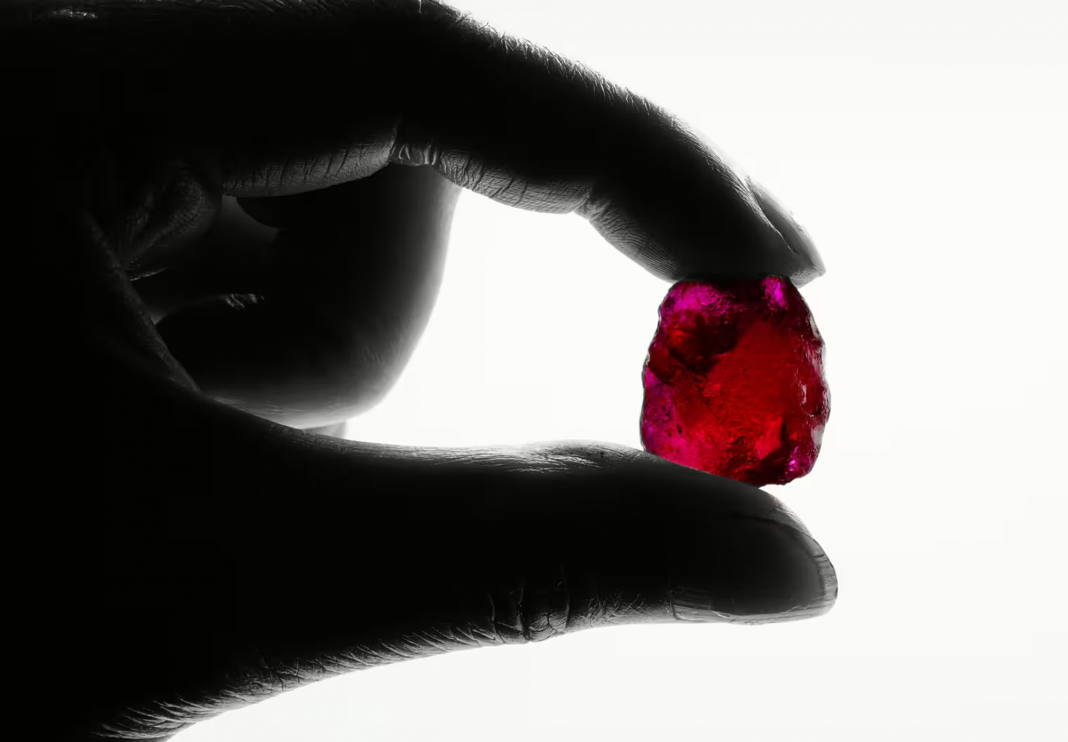Gemfields has successfully sold one of the largest rough rubies ever unearthed from its Montepuez mine in Mozambique. The 36-carat gemstone, which headlined the company’s latest auction, fetched a “highly pleasing” price, affirming the market’s continued appetite for exceptional rubies despite broader economic and geopolitical headwinds.
A landmark ruby sale from Montepuez
Gemfields’ latest mixed-quality ruby auction concluded with total revenues of $31.7 million, underscoring both the enduring appeal of rubies and the company’s strategic success in navigating a complex market landscape. Among the lots sold was a 36-carat rough ruby—one of the largest and most valuable gems ever discovered at Montepuez Ruby Mining Limitada (MRM), Gemfields’ majority-owned mine in Mozambique.
Though Gemfields did not disclose the buyer or final sale price of the 36-carat stone, it confirmed the ruby as the third most valuable by size in the mine’s history. “The sale of this stone achieved a highly pleasing price,” said Adrian Banks, Gemfields’ managing director of product and sales. The gem came from a newly explored section of the Montepuez deposit and is seen as an important marker of the region’s expanding potential.
MRM is 75 percent owned by Gemfields and 25 percent by its Mozambican partner, Mwiriti Limitada. The mine is already recognized as one of the world’s most significant ruby-producing sources, and the discovery and sale of this 36-carat stone further reinforces its global importance.
Strong auction results despite market headwinds
The June ruby auction, which consisted of six mini-auctions, achieved an 87 percent sell-through rate by lot and 69 percent by weight. The average price reached $461.48 per carat, a figure impacted by factors such as the inclusion of small-size stones in an earlier April mini-auction and a number of heavier but lower-quality stones that remained unsold this time.
Despite the lower volume compared to previous auctions, Gemfields emphasized the continued strength in demand for fine-quality rubies. “While this was our smallest mixed-quality ruby offering by weight to date, and there is clearly ongoing instability in the market stemming from, among other things, ongoing geopolitical turbulence, China’s economic difficulties, and considerable tariff uncertainty, today’s auction result demonstrated the resilience of rubies in turbulent times,” Banks said.
This performance reaffirms the position of rubies—especially those from Montepuez—as among the most desirable colored gemstones on the market, offering a form of value stability even as macroeconomic indicators remain uncertain across key markets, including Asia.
A promising outlook for Mozambican rubies

One particularly encouraging trend highlighted in this sale was the reception of “secondary-type” rubies sourced from a newer section of the Montepuez mine. These stones, which possess different characteristics than those traditionally recovered from the mine’s primary deposit zones, were generally well received by Gemfields’ auction clients.
According to Banks, this outcome signals growing market adaptability and suggests that the Montepuez mine’s diverse geology may offer broader opportunities for gem marketing and segmentation. “This is a particularly promising development,” he noted, especially as the mine moves toward completing its second processing plant (Processing Plant 2, or PP2), which will significantly enhance its capacity to process a greater volume and variety of material.
Once PP2 is operational, Gemfields expects to offer a more consistent and diversified ruby supply—better positioning itself to meet the evolving needs of the global jewelry and gemstone industries. This infrastructure investment is critical not only for efficiency but also for advancing transparency and scalability in colored gemstone production.
Mozambique’s rise in the global ruby market
Since the Montepuez mine came online in 2012, Mozambique has steadily risen to become one of the leading ruby producers in the world. Gemfields’ consistent focus on responsible sourcing, auction-based pricing, and long-term market development has helped place Mozambican rubies in high regard among jewelers, collectors, and auction houses.
The success of the 36-carat ruby sale, even without full details disclosed, is another testament to the mine’s capacity to produce record-setting stones and generate headline-grabbing results. But beyond the big-ticket items, the overall stability of ruby demand offers hope to a gemstone industry facing uneven demand for other colored stones and diamonds in recent months.
While macroeconomic uncertainty continues to weigh on consumer confidence in key markets such as China, the sustained interest in high-quality Mozambican rubies suggests these gemstones retain their allure as both aesthetic treasures and investment assets.
Looking ahead
Gemfields’ approach to auctioning rough rubies, based on transparency and open-market dynamics, continues to deliver value even in uncertain times. The recent success, anchored by the sale of the 36-carat ruby, reflects both the quality of Montepuez’s output and the resilience of gemstone markets during global turbulence.
With Processing Plant 2 nearing completion and new sections of the mine beginning to yield commercially viable rubies, Gemfields appears well-positioned to maintain and possibly expand its role in the global ruby trade. The results of this auction provide not just a financial win, but a signal of confidence—for Gemfields, for Mozambique, and for the future of colored gemstones.



